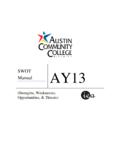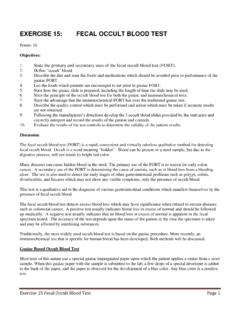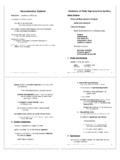Transcription of Introduction to Biotechnology - Austin Community College ...
1 BIOL1414 Lab Manual Fall 2011 1 Austin Community College , Biotechnology Department Introduction to Biotechnology Fall 2011 Linnea Fletcher, Evelyn Goss, Patricia Phelps, Angela Wheeler, and Shelley O Grady ISBN: BIOL1414F2011 BIOL 1414 Laboratory Manual BIOL1414 Lab Manual Fall 2011 2 BIOL1414 Lab Manual Fall 2011 3 Table of Contents LAB UNIT 1: Introduction TO BIOL1414 LAB .. 5 Lab Unit 1-A: Documentation: The Lab Notebook & Lab Report .. 11 Lab Unit 1-B: Biotechnology Laboratory Security & Safety .. 17 Lab Unit 1-C: Lab Equipment & Reagent Orientation.
2 25 Lab Unit 1-D: Math Skills for the Laboratory .. 31 LAB UNIT 2: CURRENT GOOD MANUFACTURING PRACTICES (cGMP) .. 39 LAB UNIT 3: BASIC TOOLS IN THE Biotechnology LABORATORY .. 85 Lab Unit 3-A: Using a 91 Lab Unit 3-B: Calibrating Lab Instruments .. 97 LAB UNIT 4: PREPARING SOLUTIONS .. 103 LAB UNIT 5: TOTAL RNA ISOLATION FROM ALFALFA SPROUTS .. 115 Lab Unit 5-A: Total RNA Isolation .. 121 Lab Unit 5-B: Denaturing Gel Electrophoresis of Total RNA .. 123 LAB UNIT 6: TRANSFORMATION OF E. coli WITH A RECOMBINANT PLASMID .. 127 LAB UNIT 7: PLASMID ISOLATION.
3 135 LAB UNIT 8: RESTRICTION ENZYME MAPPING .. 141 LAB UNIT 9: GREEN FLUORESCENT PROTEIN PURIFICATION .. 151 LAB UNIT 10: SDS-PAGE OF PURIFIED GFP .. 159 LAB UNIT 11: PCR-based VNTR Human DNA Typing .. 169 Lab Unit 11-A: Isolating DNA & PCR of VNTR Loci .. 171 Lab Unit 11-B: Analysis of VNTR loci PCR Fragments Using Agarose Gel Electrophoresis175 LAB UNIT 12: BIOREMEDIATION .. 179 LAB UNIT 13 DNA FINGERPRINTING BY SOUTHERN BLOT ANALYSIS .. 185 Lab Unit 13-A: Electrophoresis & Transfer DNA .. 187 Lab Unit 13-B: Colorimetric Detection of DNA .. 191 LAB UNIT 14 INDIRECT ELISA FOR HIV-1 DETECTION.
4 195 LAB UNIT 15 MINING BIOLOGICAL DATABASES ON THE INTERNET .. 203 Lab Unit 15-A: Hemoglobin 207 Lab Unit 15-B: Bioinformatics Translation Exercise .. 219 BIOL1414 Lab Manual Fall 2011 4 Lab Unit 15-C: Finding Mutant Sequences .. 227 APPENDIX .. 229 Appendix A: Safety Training Sheet .. 231 Appendix B: Sample Pre-Lab .. 237 Appendix C: Forms .. 239 Appendix D: Graphing Data .. 245 Appendix E: Summary of Good Laboratory Practices .. 249 Appendix F: Agarose Gel Electrophoresis with SYBR Green .. 253 BIOL1414 Lab Manual Fall 2011 5 LAB UNIT 1: Introduction TO BIOL1414 LAB Welcome to your first course in Biotechnology !
5 This course will emphasize its laboratory component to reflect the importance of your training in Biotechnology skills. Keep in mind as you work your way through this manual the specific purposes in each exercise. They will prepare you for your first job in a Biotechnology laboratory, so keep a careful record of your experience. If you carefully document and archive your work, this information will be easy for you to access later and your experiences will be more valuable in your later work. The objectives of the lab portion of the course are to.
6 O Develop the basic laboratory techniques of a Biotechnology or bioscience lab o Supplement and enrich the lecture portion of the course, which deals predominantly with Biotechnology techniques o Develop critical thinking skills in the students o Encourage teamwork and accountability among the students o Practice accuracy in calculations and in writing scientifically o Develop multitasking skills o Encourage students to take charge of their learning o Learn the responsibilities associated with working in a company Students are expected to behave professionally at all times.
7 Lab notebooks will be maintained and graded in the lab. The lecture will provide background and relevant information about the solutions, prep, procedure and related techniques. Required Texts/Materials Textbooks: Seidman & Moore, Basic Laboratory Methods for Biotechnology : Textbook & Laboratory Reference, 2nd edition. 2009. Prentice Hall. ISBN: 0321570146 Lab Manual: BIOL1414 Introduction to Biotechnology Laboratory Manual One copy of the lab manual will be supplied. Supplies: 3 Ring Binder (Lab notebook), Scientific Calculator with statistics and linear regression capability, Sharpie labeling pens (fine tip).
8 Lab Safety: Safety glasses with a rating of Z87 and close-toed shoes Before you can begin working in an ACC laboratory, you must first 1. View the ACC Science Safety video. 2. Tour the laboratory with your laboratory instructor to locate emergency equipment and procedures. 3. Sign a safety contract, by which you agree to comply with safety regulations. We hope that you enjoy your experience in this introductory course. Following is a discussion of Biotechnology , and a description of some of the activities that you will be doing in this course. BIOL1414 Lab Manual Fall 2011 6 What is Biotechnology ?
9 Strictly speaking, Biotechnology is the use of a living organism for one s own benefit. By this definition, Biotechnology would date back to the very beginnings of civilization, when humankind first learned to cultivate crops and domesticate animals in a system of agriculture. When one thinks of modern Biotechnology , however, gene splicing and recombinant organisms take center stage. Biotechnology was revolutionized when scientists first learned how to isolate and clone genes, allowing for genetic engineering. Today, the Biotechnology industry has grown and expanded to affect us on a day-to-day basis.
10 Below is an excerpt from that discusses the ever expanding applications of Biotechnology in healthcare, agriculture and energy ( ). Biotechnology : Healing, Fueling, and Feeding the World At its simplest, Biotechnology is technology based on biology - Biotechnology harnesses cellular and biomolecular processes to develop technologies and products that help improve our lives and the health of our planet. We have used the biological processes of microorganisms for more than 6,000 years to make useful food products, such as bread and cheese, and to preserve dairy products.










